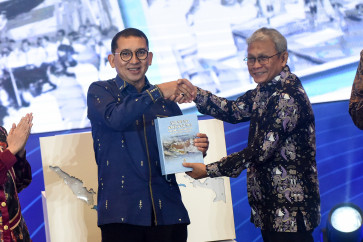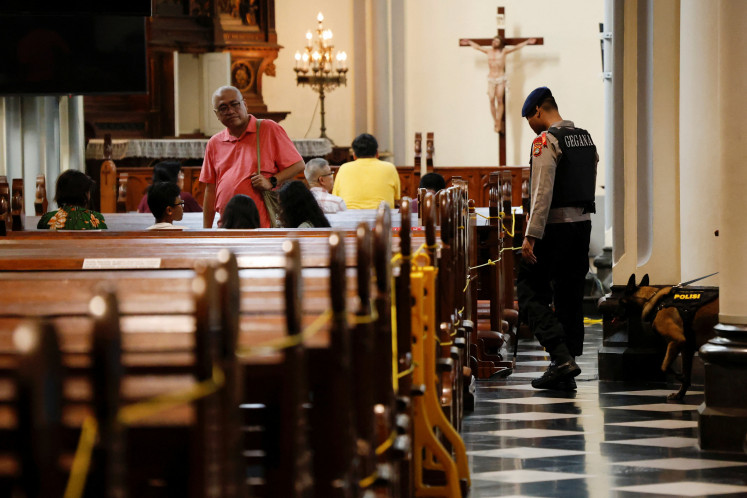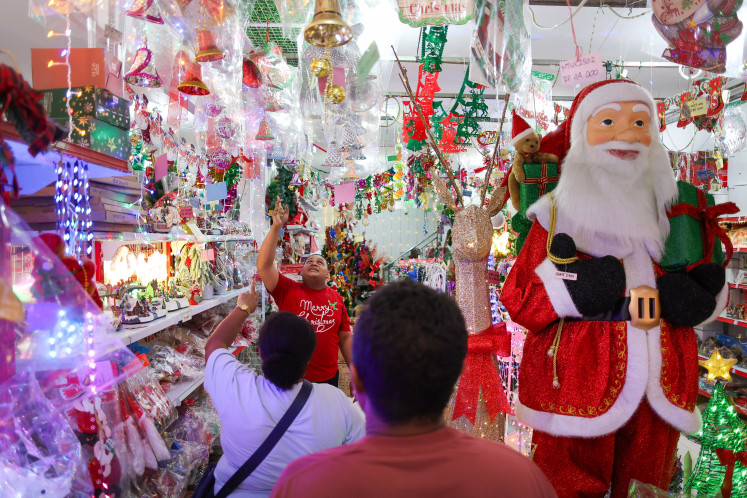Popular Reads
Top Results
Can't find what you're looking for?
View all search resultsPopular Reads
Top Results
Can't find what you're looking for?
View all search resultsSumba's textiles take center stage in Paris
A view of Sumba artifacts plus textiles at LâEspace Asia in Paris
Change text size
Gift Premium Articles
to Anyone
A view of Sumba artifacts plus textiles at L'Espace Asia in Paris.
Textile art from Sumba has reached Espace Asia in Paris, a show that may seem small in contrast to bigger galleries but one where the textiles are well-displayed for visitors.
The show, which also provides abundant information for visitors via brochures and audio-visual displays, is timely, with Indonesia recently having filed an application for ikat textiles from East Sumba to be recognized as part of UNESCO's intangible cultural heritage of humanity list, scheduled for 2014.
Anthropologist Antonio Guerreiro, a co-founder of the Apo Kayan association that promotes the material cultures of the Indonesian archipelago and Southeast Asia, visited Sumba at the end of 2012.
'I went to Sumba to investigate the production of ikat textiles that had been partially researched by my deceased professor, Danielle Geirnaert,' he says. Here, Guerreiro met with various village groups who were involved in the renaissance of traditional ikat textiles.
'I found there was a vibrant evolution in the making of ikat textiles. It started in the 1980s and although the iconographic motifs have been modified, natural dyes are used as much as possible and the colors are almost the same.'
Traditionally, the cloth is woven with hand spun cotton yarns, locally grown and spun.
The word ikat means tying a knot, which is part of the process of dyeing the threads that have been tied into bundles beforehand to resist the dye when the yarn is dipped into the dye-color vats.
Men usually tie these knots in the process of multiple resist dyeing before the dyed threads are stretched on looms to be woven into textiles by skilled women weavers.
These textiles traditionally follow all the life-stages of the Sumbanese people, playing an important part in rituals and beliefs.
Modern-day textiles of good quality were acquired directly from various villages by Guerreiro together with Cecile Bigeon from Asia Travel so they could be exhibited and then sold during a six-month travelling exhibition, which runs from Paris to Toulouse and then Lyon until March next year, to benefit the various initiatives and work groups on Sumba.
Deidi von Schaewen's photo wall.
'We believe in working together with residents in developing their resources and environment so that our clients really get a feeling for the culture and people when they travel with us,' said Jean-Paul Chantraine, director of the travel agency Asia, during the exhibition opening.
Indonesian Ambassador to UNESCO Carmadi Machbub praised the exhibition, saying such an initiative would help make people much more aware of Indonesia's heritage.
The Paris exhibition displays 15 ikat pieces mainly from East Sumba, together with two ikat textiles from Chantraine's private collection dating from his 1998 visit to the island.
The motifs of these ikat textiles are complex but symmetrical. These include large blankets called kain hinggi, scarves and tubular woven skirts in a rich palette of colors.
Other pieces from the western regions of Kodi, Loli and Laboya feature large fringes, alternate stripes, flowers or stylised plants and the use of supplementary weft, which creates the effect of embroidery on a background of white, indigo or black.
Other artefacts ' such as pandanus and palm baskets, pottery pieces made in Laboya village, jewellery called tabello or hai kara, together with small wooden sculptures on show, evoke the atmosphere of the Sumbanese in Paris.
The exhibition includes extracts of a film on Sumba's funeral rites and about the tarik batu rite, which means transporting gigantic flat stones to honor a recently deceased raja (king).
Guerreiro's documentary photos are shown at the exhibition, while Deidi von Schaewen's photographs are printed on canvas frames, giving a striking impression of Sumbanese local life, weavers and ancient monuments.
'The ultimate aim of this exhibition is that buyers, whether from Indonesia or from Europe, can purchase directly from village initiatives either on the spot or through other venues,' Bigeon says.
' Photos courtesy of Espace Asia












